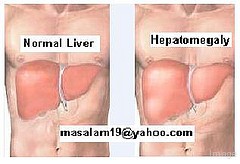Liver Cancer facts
What is liver cancer?
The liver has multiple important functions. One of its main functions is filtering the blood and converting nutrients and drugs absorbed from the digestive tract into ready-to-use chemicals. The liver is a very sensitive organ and accessible to cancer cells living in the bloodstream, as all the blood passes through this organ.
The liver cancer may originate from 2 sources: the liver can be affected by the very liver cancer or by cancer spreading from other sites to the liver. Most liver cancer is found to be secondary or metastatic. In other words, it originates from other areas of the body, usually including the breast, colon or lung.
Symptoms
In many people liver cancer symptoms and signs are not evident in the early stages. It means that this kind of liver cancer cannot be diagnosed until it becomes enough advanced. The following symptoms (all or some of them) may appear in the advanced stage of the disease:
- Nausea and vomiting
- An enlarged liver
- Loss of appetite and weight
- General weakness and fatigue
- Abdominal pain, which may also spread to your back and shoulder
- A yellow discoloration of your skin and the whites of your eyes (jaundice)
- Abdominal swelling.
Causes
Primary liver cancer (hepatocellular carcinoma) may occur as a result of damaged liver by birth defects, alcohol abuse, or infected with chronic infection diseases like hemochromatosis (excessive amount of iron in the liver), hepatitis B and C, and cirrhosis. Statistics shows that more than 50 percent of all people diagnosed with liver cancer also suffer from cirrhosis (this scarring condition of the liver usually originates from above mentioned factors including alcohol abuse (well explained at AlcoholrehabMn alcohol abuse guide), diabetes, hepatitis B and C that damage this organ).
In addition to this fact, it is supposed that those who have genetic hemochromatosis (a disease of iron overload) are at greater risk to experience liver cancer.
Risk factors:
Actually, primary liver cancer can affect everyone at any age. But there are some risk factors for this disease:
- Sex : Men are more likely to experience this type of cancer compared to women. The reason is not clear yet.
- Age : According to recent reports, in the U.S. and Europe, liver cancer affects people at age about 60 on average. But people from Asia and Africa have been diagnosed with this disease at age between 20 and 50.
- Cirrhosis and Chronic infection : Hepatitis B and C. Cirrhosis and Hepatitis B and C increase the risk for liver cancer.
- Diabetes : People with diabetes are at a greater risk of liver cancer than people who don’t suffer from diabetes, according to HowIsDiabetesCaused.com what causes diabetes guide.
- Exposure to aflatoxins : Consuming foods contaminated with aflatoxins is very dangerous, as the toxin produced by fungus can expose consumers to higher risk of liver cancer. One should avoid especially crops such as corn, maize, soybeans and peanuts that are contaminated with aflatoxins.
There are also other risk factors, including alcohol abuse, Cigarette Smoking and Bile duct cancer.
Prevention
It is not always possible to prevent liver cancer. The only thing one can do is to greatly reduce the risk by protecting himself/herself from hepatitis B and C, cirrhosis and other diseases that can cause liver cancer. Also avoid medicament that may lead to liver damage.
Types
Benign tumors and cell of origin:
- Hepatocytes: Focal nodular hyperplasia; Adenoma
- Bile duct: Adenoma; Hamartoma
- Vessels: Hemangioma.
List of malignant (cancerous) tumors and cell of origin
- Hepatocytes: Fibrolamellar carcinoma, Hepatocellular carcinoma, Hepatoblastoma
- Bile duct: Cholangiocarcinoma
- Vessels: Angiosarcoma.
Diagnosis
Liver cancer has specific features, like increase in size or intensive blood supply, which can be detected by imaging techniques such as Computed Axial Tomography (CT) scan / Magnetic Resonance Imaging (MRI) or angiography.
If these techniques cannot help, then a fine needle biopsy may be applied to determine if a tumor is benign or malignant.
Facts
- About 18,000 patients are affected by primary liver cancer each year.
- About 12 000 people in US alone are diagnosed with hepatocellular carcinoma (primary liver cancer) each year.
- Recent reports show that the amount of patients diagnosed with liver cancer in the US and worldwide is increasing day by day.
- If the surgery didn’t help, the disease is usually fatal within 3-6 months.

